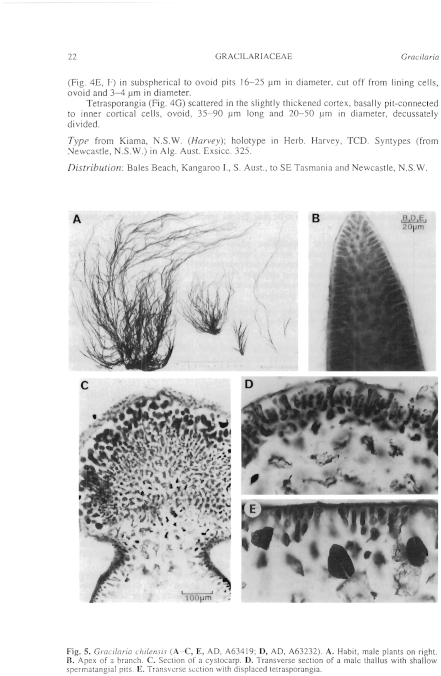|
|
|
|
|
|||||||||||
|
Electronic Flora of South Australia Species Fact Sheet
Phylum Rhodophyta – Class Florideophyceae – Order Gracilariales – Family Gracilariaceae
Selected citations: Adams 1994: 178, pl. 56 upper centre. Bird et al. 1990: 375, figs 1–5.
Synonym
Gracilaria sordida Nelson 1987: 90, figs 6–9.
Thallus (Fig. 5A) dark red-brown, 10–60 cm high, irregularly branched with long main branches and numerous laterals of varying length, apices acute, branches terete, 0.4–0.8 (–1) mm in diameter for most of their length, 0.2--0.4 mm in diameter close to the apices, not basally constricted. Holdfast discoid, 2–3 mm across, with one to a few fronds; epilithic or loose lying. Structure uniaxial, with a slightly protruding apical cell (Fig. 5B), soon becoming pseudoparenchymatous, grading in cell size from the outer cortex to inner medullary cells, cortex 2–3 cells thick, outer cells ovoid (often slightly palisade like) and 4–7 µm across in surface view, L/D 1.5–2.5 in section, with larger hair basal cells (15–20 µm long and 6–8 µm in diameter); medulla 6–12 cells across, inner medullary cells ovoid, 40–100 (–180) µm in diameter, developing thick walls (10–30 µm) and numerous secondary pit-connections; secondary thickening of lower branches not present. Rhodoplasts discoid.
Reproduction: Gametangial thalli dioecious. Carpogonial branches unreported. Carposporophytes (Fig. 5C) with a small basal fusion cell and dense pseudoparenchymatous gonimoblast cells with numerous pit-connections, producing chains of carposporangia, when mature ovoid to clavate and 16–30 µm in diameter; traversing nutritive cells usually present between lower gonimoblast cells and basal tissue of the cystocarp. Cystocarps scattered, sessile, hemispherical, conical to globular and basally constricted, 500–800 µm in diameter; pericarp 80–100 µm thick, with anticlinal rows of 6–9 cells, ostiolate; inner pericarp absent. Male plants usually small (5–10 cm high); spermatangia (Fig. 5D) formed at the base of relatively shallow pits, 12–20 µm across, surrounded by clavate cells 15–20 µm high and 4–6 µm in diameter; spermatangia 2–3 µm across.
Tetrasporangia (Fig. 5E) scattered in the cortex, basally pit-connected, ovoid, 40–55 µm long and 25–40 µm in diameter, cruciately to almost tetrahedrally divided.
Type from Penco, Bahia Concepción, Chile (Romo, 1.ix.1982); holotype and isotypes in NRCC, 9131(a) and (b).
Selected specimens: Cowell, S. Aust., floating in Salt Creek (Hone & Clark, 24.viii.1993; AD, A62991). Port Wakefield, S. Aust., mid eulittoral pools in mangroves (Womersley, 26.iii.1950; AD, A13017). Onkaparinga R. estuary, S. Aust., about 40 cm deep just within mouth (Inns & Thomas, 13.viii.1973; AD, A43893 and Womersley, 12.xii.1993; AD, A63232). Beacon 19 Boat Ramp, Sir Richard Pen., The Coorong, S. Aust., drift (Womersley, 14.ii.1994; AD, A63338). American River inlet, Kangaroo I., S. Aust., on tidal flats (Womersley, 1.ii.1946; AD, A3153). Glenelg R. Est., (Nelson), Vic., near low water just inside mouth (Womersley, 14.iv.1994; AD, A63419 -"Marine Algae of southern Australia" No. 377). Hobsons Bay, Port Phillip, Vic., 0–0.5 m deep at Power Station outfall (Watson, 1.v.1972; AD, A42342). Crawfish Rock, Westernport Bay, Vic., 6 m deep (Watson, 28.v.1974; AD, A45421). Long Bay, Port Arthur, Tas., littoral sand-mud bank (Cribb 115.1, 22.i.1951; AD, A16195).
Distribution: Chile, from Bahia Herradura to Rio Maullin. New Zealand.
In southern Australia, from Cowell, Eyre Pen., S. Aust., to Hobsons Bay, Vic., and probably Port Arthur, Tasmania (male specimens not seen).
Taxonomic notes: G. chilensis appears to be largely confined to river mouths or estuaries, as in Chile and New Zealand. It is a slender species with long main branches and laterals of irregular lengths, with a single apical cell usually visible in the acute branch tips. It is distinguished in particular by the spermatangial pits (of the "textorii" type) with relatively long clavate cells surrounding them and spermatangia cut off from cells in the relatively flat base.
Identity of the Australian material with the Chilean species has been checked by Dr Carolyn Bird (pers. comm.).
References:
ADAMS, N.M. (1994). Seaweeds of New Zealand. (Cant. Univ. Press: Christchurch.)
BIRD, C.J., NELSON, W.A., RICE, E.L., RYAN, K.G. & VILLEMUR, R. (1990). A critical comparison of Gracilaria chilensis and G. sordida (Rhodophyta, Gracilariales). J. Applied Phycol. 2, 375–382.
NELSON, W.A. (1987). The New Zealand species of Gracilaria Greville (Rhodophyta, Gigartinales). N.Z. J. Bot. 25, 87–98.
The Marine Benthic Flora of Southern Australia Part IIIB complete list of references.
Publication:
Womersley, H.B.S. (28 June, 1996)
The Marine Benthic Flora of Southern Australia
Rhodophyta. Part IIIB. Gracilarialse, Rhodymeniales, Corallinales and Bonnemaisoniales
Reproduced with permission from The Marine Benthic Flora of Southern Australia Part IIIB 1996, by H.B.S. Womersley. Australian Biological Resources Study, Canberra. Copyright Commonwealth of Australia.
Illustration in Womersley Part IIIA, 1996: FIG. 5.

Figure 5 enlarge
Fig. 5. Gracilaria chilensis (A–C, E, AD, A63419; D, AD, A63232). A. Habit, male plants on right. B. Apex of a branch. C. Section of a cystocarp. D. Transverse section of a male thallus with shallow spermatangial pits. E. Transverse section with displaced tetrasporangia.

|
Email Contact: State Herbarium of South Australia |

|